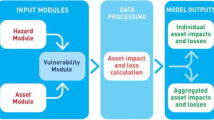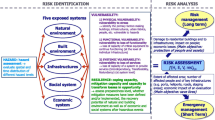Abstract
Volcanic eruptions typically produce a number of hazards, and many regions are at risk from more than one volcano or volcanic field. So that detailed risk assessments can be carried out, it is necessary to rank potential volcanic hazards and events in terms of risk. As it is often difficult to make accurate predictions regarding the characteristics of future eruptions, a method for ranking hazards and events has been developed that does not rely on precise values. Risk is calculated individually for each hazard from each source as the product of likelihood, extent and effect, based on the parameters’ order of magnitude. So that multiple events and outcomes can be considered, risk is further multiplied by the relative probability of the event occurring (probabilitye) and the relative importance of the outcome (importanceo). By adding the values obtained, total risk is calculated and a ranking can be carried out.
This method was used to rank volcanic hazards and events that may impact the Auckland Region, New Zealand. Auckland is at risk from the Auckland volcanic field, Okataina volcanic centre, Taupo volcano, Tuhua volcano, Tongariro volcanic centre, and Mt. Taranaki volcano. Relative probabilities were determined for each event, with the highest given to Mt. Taranaki. Hazards considered were, for local events: tephra fall, scoria fall and ballistic impacts, lava flow, base surge and associated shock waves, tsunami, volcanic gases and acid rain, earthquakes and ground deformation, mudflows and mudfills, lightning and flooding; and for distal events: tephra fall, pyroclastic flows, poisonous gases and acid rain, mudflows and mudfills, climate variations and earthquakes. Hazards from each source were assigned values for likelihood, with the largest for tephra fall from all sources, earthquakes and ground deformation, lava flows, scoria fall and base surge for an Auckland eruption on land, and earthquakes and ground deformation from an Auckland eruption in the ocean. The largest values for extent were for tephra fall and climate variation from each of the distal centres. However, these parameters do not give a true indication of risk. In a companion paper the effect of each hazard is fully investigated and the risk ranking completed.



Similar content being viewed by others
References
Allen SR (1992) Volcanic hazards in the Auckland volcanic field. Unpublished MSc thesis, University of Auckland, Auckland, New Zealand, pp 1–153
Allen SR, Smith IEM (1994) Eruption styles and volcanic hazard in the Auckland volcanic field, New Zealand. Geosci Rep Shizuoka Univ 20:5–14
Auckland Engineering Lifelines Group (2001) Volcanic ash review, Part 1. Auckland Regional Council Technical Publication No 144. Auckland Regional Council, Auckland, pp 1–50
Auckland Regional Council (1999) Auckland Engineering Lifelines Project, Final report Stage one. Auckland Regional Council Technical Publication No 112. Auckland Regional Council, Auckland, pp 1–286
Blong RJ (1984) Volcanic hazards: A sourcebook on the effects of eruptions. Academic, Sydney, Australia, pp 1–424
Blong RJ (1996) Volcanic hazards risk assessment. In: Scarpa R, Tilling RI (eds) Monitoring and mitigation of volcano hazards. Springer, Berlin Heidelberg New York, pp 675–698
Blong RJ (2000) Volcanic hazards and risk management. In: Sigurdsson H, Houghton BF, McNutt SR, Rymer H, Stix J, Ballard RD (eds) Encyclopedia of volcanoes. Academic, San Diego, CA, pp 1215–1227
Blong RJ (2003) Building damage in Rabaul, Papua New Guinea, 1994. Bull Volcanol 65:43–54
Cassidy J, Locke CA, Smith IEM (1986) Volcanic hazard in the Auckland region. In: Gregory JG, Watters WA (eds) Volcanic hazards assessment in New Zealand. New Zealand Geological Survey, Lower Hutt, New Zealand, pp 60–64
de Lange WP, Hull AG (1994) Tsunami hazard for the Auckland region. Auckland Regional Council Technical Publication No 50. Auckland Regional Council, Auckland, pp 1–37
de Lange WP, Prasetya G (1999) Volcanoes and tsunami hazard – implications for New Zealand. Tephra 18:30–35
Johnston DM (1998) Modelling ash distribution for Auckland scenarios. Institute of Geological and Nuclear Sciences Client Report 71770D.10A. Institute of Geological and Nuclear Sciences, Lower Hutt, New Zealand, pp 1–12
Kermode L (1992) Geology of the Auckland urban area. Scale 1:50,000. Institute of Geological and Nuclear Sciences geological map 2. Institute of Geological and Nuclear Sciences Ltd, Lower Hutt, New Zealand, pp 1–63 + 1 sheet
Magill CR, Blong RJ (2004) Volcanic risk ranking for Auckland, New Zealand. II: Hazard consequences and risk calculation (this volume)
Mills MJ (2000) Volcanic aerosol and global atmospheric effects. In: Sigurdsson H, Houghton BF, McNutt SR, Rymer H, Stix J (eds) Encyclopedia of volcanoes. Academic, San Diego, CA, pp 931–943
Nelson CS, Kamp PJJ, Mildenhall DC (1989) Late Pliocene distal silicic ignimbrites, Port Waikato, New Zealand: implications for volcanism, tectonics, and sea-level changes in South Auckland. New Zeal J Geol Geop 32:375–370
Newhall CG, Self S (1982) The volcanic explosivity index (VEI): An estimate of explosive magnitude for historical volcanism. J Geophys Res 87:1231–1238
Newnham RM, Lowe DJ (1991) Holocene vegetation and volcanic activity, Auckland Isthmus, New Zealand. J Quaternary Sci 6:177–193
Newnham RM, Lowe DJ, Alloway BV (1999) Volcanic hazards in Auckland, New Zealand: a preliminary assessment of the threat posed by central North Island silicic volcanism based on the Quaternary tephrostratigraphical record. In: Firth CR, McGuire WJ (eds) Volcanoes in the Quaternary. Geological Society Special Publication No 161. The Geological Society, London, pp 27–45
Pareschi MT, Cavarra L, Favalli M, Giannini F, Meriggi A (2000) GIS and volcanic risk management. Nat Hazards 21:361–379
Sandiford A, Alloway BV, Shane P (2001) A 28 000–6600 cal yr record of local and distal volcanism preserved in a paleolake, Auckland, New Zealand. New Zeal J Geol Geop 44:323–336
Searle EJ (1981) City of volcanoes: A geology of Auckland. Longman Paul, Auckland, New Zealand, pp 1–195
Self S, Rampino MR, Barbera JJ (1981) The possible effects of large 19th and 20th century volcanic eruptions on zonal and hemispheric surface temperatures. J Volcanol Geoth Res 11:41–60
Shane P, Hoverd J (2002) Distal record of multi-sourced tephra in Onepoto Basin, Auckland, New Zealand: implications for volcanic chronology, frequency and hazards. Bull Volcanol 64:441–454
Smith IEM, Allen SR (1993) Volcanic hazards at the Auckland volcanic field. Ministry of Civil Defence Volcanic hazards information series No 5. Ministry of Civil Defence, Wellington, pp 1–34
Spörli KB, Eastwood VR (1997) Elliptical boundary of an intraplate volcanic field, Auckland, New Zealand. J Volcanol Geoth Res 79:169–179
Statistics New Zealand (1999) New Zealand – A regional profile: Auckland. Statistics New Zealand: Te Tari Tatau, Wellington, New Zealand, pp 1–45
Turner GM, Robinson N, Verosub K L (2002) Preliminary palaeomagnetic results from the holocene sediments of Lake Pupuke, Auckland, New Zealand. Eos T AGU West Pac Geophys Meet Suppl 83:125
Williams-Jones G, Rymer H (2000) Hazards of volcanic gases. In: Sigurdsson H, Houghton BF, McNutt SR, Rymer H, Stix J (eds) Encyclopedia of volcanoes. Academic, San Diego, CA, pp 997–1004
Wilson CJN, Stirling MW (2002) Towards a probabilistic volcano hazard analysis model for New Zealand. In: Johnston DM, Tilyard D (eds) Proc 5th Natural Hazards Management Conf. Te Papa, Wellington, 14–15 August 2002. Institute of Geological and Nuclear Sciences, Lower Hutt, New Zealand, pp 73–81
Wilson CJN, Houghton BF, Kamp PJJ, McWilliams MO (1995) An exceptionally widespread ignimbrite with implications for pyroclastic flow emplacement. Nature 378:605–607
Acknowledgements
We would like to thank Professor John McAneney and Dr. Keping Chen for helpful reviews of an early draft, and Dr. Ian Smith for valuable discussions. The manuscript has benefited from reviews and advice from Dr. David Johnston, Dr. Steve Oldfield, and an anonymous referee. Risk Frontiers is grateful for the strong support of a number of sponsors in the insurance industry. This work was completed while Christina Magill was holding a Macquarie University Research Award for Areas and Centres of Excellence (RAACE).
Author information
Authors and Affiliations
Corresponding author
Rights and permissions
About this article
Cite this article
Magill, C., Blong, R. Volcanic risk ranking for Auckland, New Zealand. I: Methodology and hazard investigation. Bull Volcanol 67, 331–339 (2005). https://doi.org/10.1007/s00445-004-0374-6
Received:
Accepted:
Published:
Issue Date:
DOI: https://doi.org/10.1007/s00445-004-0374-6




